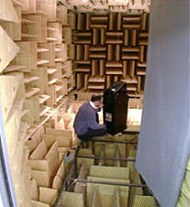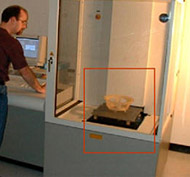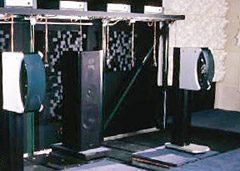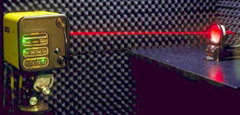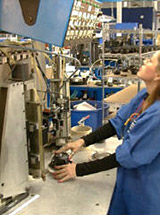![[SoundStage!]](../sslogo3.gif) The Y-Files The Y-FilesBack Issue Article |
|||||
April 2001 The Tao of Speaker Design -- Part 1 with Revel Loudspeakers The paradox About truth, Lao Tzu quipped that those who knew remained quiet while those who talked about it didn’t know. Faced with his Tao Te Ching of 5000 words, admirer Po Chui wondered aloud why the Old Man dispensed with such poignant loquaciousness if truth indeed was as entirely beyond words as the axiom reads. The Tao of speaker design is equally paradoxical. Those who design loudspeakers do so silently without much ado. Those who disagree about the minutiae of engineering choices remain endlessly at odds, but they tend to not know how to create proper speakers themselves. If, like Po Chui, you are sensitive to this innate dilemma, you’ll also notice something else. Even amongst accredited designers, ideas on what constitutes the right approach diverge widely. The added fact that so many successful speakers are based on conflicting notions and various applied philosophies makes the truth of the matter even more elusive. To interview different speaker designers clearly won’t yield ultimate answers. Unfortunately, our small minds are habitually stumped by paradox. They long for answers of finality well beyond ambiguity. Maybes or multiplicities tend to vex us. The truth itself, of course, has no problems with embracing polar opposites whatsoever. Light, for example, behaves both as a wave and a particle. Contrary to appearances, one might thus expect that on a deeper level, divergent answers on any subject could somehow prove to be complementary friends rather than old adversaries locked into heads-on combat. Also, opposing forces tend to cancel each other out. Taken to the final end, this could leave one with only the empty space of peaceful silence that obliterates any and all questions. If that seems counter-intuitive, consider that you may not be living the very depths of Tao. You see, the human condition proves that ultimate "anythings" are perpetually impossible. Naturally, the sages remind us that there is no ultimate truth, except for the one that states that there isn’t one, period. Kind of like nothing is constant except change. But for us non-saints, questions remain the perennial occupation of our creative minds. Let’s cast out our line then and fish for speaker-design answers today. The ways of ignorance… Looking for a perfectly promising spot to start unwinding my fishing rod and catch some heavy specimens of engineering-driven answers, I contacted Kevin Voecks, director of research and technology for the engineering team at Revel. Instead of being a smart bass by evading my insidious hooks, Voecks proved delightfully insistent on biting down. If only actual fish behaved with such sporting grace. But before I take this simile too far, let’s begin by stating that from its inception, the Revel team was committed to solving the old subjectivist/objectivist conflict. By fusing the complementary opposites, they wedded the protagonists: If something measures right, it will sound right and, if it sounds right, it will measure right. This meant coming up with novel ways to measure sonic occurrences that proved audible but eluded conventional measurements. It also meant intensive reliance on double-blind listening tests in optimized environments to correlate measurements with audibility.
Blessed with the proper financial resources of the huge Harman International conglomerate via annexation into the Madrigal family -- which also includes the Mark Levinson, Proceed, Madrigal Imaging and Audio Access brands -- the Revel team set out to map their engineering wish list. Build three state-of-the-art anechoic chambers. Add four conventional listening rooms, two configurable listening rooms and one pneumatically actuated speaker moving system for uncompromised and true double-blind listening; contain the major production steps in-house and minimize reliance on OEM suppliers. This latter bit was to include the capability to generate transducer parts prototypes within 24 hours via a hi-tech 3-D CAD transfer to a stereo lithography machine. Hand-tune each crossover to the actual transducer for consistency and insure 0.5dB product compliance with reference models. Perform on-site all cabinet finishing, a comprehensive 16-step three-stage paint-and-lacquer process, plus perform intensive documentation of each individual production unit for tracking and service purposes. To give you a sense of scale, the cabinet finishing facility alone cost $3 million.
It seems fair to pronounce that seemingly no expense was spared to create the actual facility wherein attempts would be made to correlate measurements and listening impressions to an extent possibly beyond what has previously been attempted. … lead to surprising discoveries Spearheaded by Voecks, formerly of Mirage and Snell, right-hand-manned by the famous Floyd Toole, who at the NRC in Canada pioneered the scientific speaker measurement protocol as we know it today, the Revel team set out to identify, in sequence of relevance, the most important loudspeaker design parameters. As a former first-order proponent who, in the early '80s, reconsidered certain positions based on research conducted by Dr. Stanley Lipshitz of the University of Waterloo, Voecks couldn’t have been surprised at some of the results. The two stout pillars of the first-order religion -- cast out thy evil spirits and preserve Ye both the original waveform and its phase relationship -- turned out to be the least important. In fact, of seven target criteria, waveform preservation was found to reside below the actual threshold of audibility. According to Revel’s research, phase fidelity rests just marginally above. The other five very audible qualities, starting with the most dominant one, are: timbre, directivity, resonance, distortion, and dynamics. Timbre is said to be by far the most complex because it’s a function of room acoustics, speaker and listener location within the room, and thus their combined interaction of direct, early and reverberant reflections. Because all sounds emanating from the speaker eventually reach the ear, directivity is deemed second-most important and directly related to correct reproduction of timbre. Resonance, whether created by the actual transducer or cabinet, creates interference patterns and thus distortion products. Those must remain below the audibility limit. Distortion itself operates via frequency-dependent thresholds. Revel’s research showed how even very low-amplitude low-Q resonances are just as audible as are far more visible high-Q resonances. Prior to their research, these very tiny graphic deviations would have been considered inaudible. Manufacturers that still rely on electronic gating simulations of anechoic chambers can’t even detect the presence of resonances in most cases, much less come up with engineering solutions to minimize or suppress them. Dynamic compression -- the non-linearities that occur in transducer behavior when excursion increases and voice coils heat up -- is deemed the last major challenge of the five key issues. The heating of the voice coil causes an increase in its native impedance that in turn mis-terminates the associated crossover network. This misalignment causes often-dramatic response changes. Simultaneously, the transducers stop increasing their output levels in linear relationship to the input signal. In a multi-way system, multiple drivers cover different frequency ranges and exhibit different heating and cooling properties. Unaccounted for, this can cause massive problems. Say the input signal increased by 10dB above the linearity threshold. One driver in our arbitrary multi-way might only be able to track this amplitude increase by 3dB. The other drivers will suffer different offsets and display different initiation and recovery times from this non-linear aberration. Envision the end result. During dynamic peaks, this system selectively "comb-filters" its amplitude modulation based on frequency, but further, this distortion occurs in both the amplitude and time axis due to the varying recovery behavior of different drivers. No wonder so many speakers sound compressed during massive crescendos, as though certain parts of the spectrum lagged behind others. This in fact is what actually happens. Revel’s solution to dramatically reduce this effect is to use far larger than common voice coils, both in width and length -- in certain models, for example, 1.5" diameter voice coils in 4" drivers or 2" diameter ones in 5.25" drivers -- and use high-order filters as well as optimized crossover frequencies. While heretical to the shallow-slope proponents, the Revel team found no evidence to support the notion that utter fidelity to the original waveform is of paramount importance. Kevin Voecks added that so-called "phase perfect" transducers remain such only within an anechoic chamber and act anything but in a real-world, reverberant environment. Contrary-minded challengers so inclined could add their own private sessions to Revel’s 1000+ double-blind listening tests. Would such first-order philosophers actually hear the effects that, according to their priorities, networks other than first order are supposed to induce in terms of phase shift and time-domain errors?
Revel’s three anechoic chambers include one at 5000 square feet naturally anechoic to 180Hz at 4pi, one at 10,000 square feet that’s flat to 60Hz and tightly equalized to +/- 0.5dB between 60Hz and 20Hz, and one at 7000 square feet with 2pi for raw-driver testing. To insure fair comparisons during listening sessions, a fully automated speaker-moving setup can swap out speakers hidden behind a curtain and insert the replacements into exactly the same physical location as the ones removed. The different Revel listening rooms carry amongst them the predominant acoustic characteristics of rooms from all over the world. In two of them, even the acoustic treatments are movable to configure differently tuned environments. These facilities indicate that properly applied engineering doesn’t rest in the lab but has to concern itself with how theories and idealized test environments translate into the real world with its countless variables. Power corrupts, but not in this case Voecks talks about a phenomenon called "sound power." This refers to the total in-room sound pressure produced by the speaker, amplified by the room and sensed at the ear. Most of the sound that arrives at the ear is unfortunately reflected and no longer direct sound. Therein lies a liability. With rising frequencies, transducers turn more and more beamy. They no longer act as a broad-dispersion sound source but more like a spotlight. It follows that the tighter this sound beam is focused, the less reflective amplification it receives from the room. Envision dispatching an attacker with one of those fancy chop-suky moves, using your hand like a multi-headed chisel, fingers akimbo and stiffened like pincers. Delivered with the same force (on-axis response), there’s a huge difference in impact whether you use just one finger (beamy) or all five (including reflections). It’s intuitive to grasp that if a speaker’s output were purely designed according to its measured flat on-axis response, it would cause a major suck-out in the upper midrange to treble band when measured in an actual room’s listening position. To account for the loss of sound power in the treble, Revel adds rear-firing tweeters to their Ultima Series models. This corrects perceived tonal balance by filling in the natural dropout that would otherwise result from tweeter beaming. Depending on room-boundary variables, these rear tweeters can be turned off. This entire sound power subject is very complex and beyond the scope of this survey. However, its most sensitive application centers on the upper and lower crossover regions of the midrange. Revel indicated that many competitors use overly large midranges joined to tweeter crossover frequencies that are set too high. This might result in flat on-axis response, but it also incurs very colored off-axis behavior. The first reflections are compromised and sound power degraded. A very noticeable coloration occurs throughout the region in which the midrange is becoming increasingly directional. The basic sound power premise holds that controlled and consistent dispersion coupled with smooth off-axis response up to 75 degrees is vitally important for best in-room performance under real-world conditions. Colored off-axis response degrades timbre in both early arrival and reverberant field response. It also causes greater sensitivity to room placement when, especially at midrange and upper frequencies, the on- and off-axis behavior vary widely. It’s important to remember that while an isolated, flat on-axis measurement looks impressive on paper, it may sound anything but unless accompanied by an equally smooth off-axis family of curves. Voecks pointed out that while certain manufacturers already consider smooth off-axis response up to 30 degrees, their own research shows that the majority of first side-wall reflections actually occur as far as 60-75 degrees off-axis. He believes that Revel is one of only very few manufacturers that not only produces measurements up to 75 degrees off-axis but deliberately designs their speakers for the most consistent and uniform response in such a broad horizontal field. Incidentally, SoundStage! also produces measurements at 0, 15, 30, 60, and 75 degrees in a true anechoic environment -- the only North American-based publication to do so. How to apply measurements matters as much as taking them in the first place To predict final in-room performance, Revel practices what’s called simple spatial averaging. It combines various +/- 10-, 20- and 30-degree left/right and 10-degree up/down response curves and avoids the measuring blindness that occurs with one-third-octave smoothing. A spatially averaged frequency-response curve does show spectral balance and bandwidth as well as resonant spikes. If an apparent resonance on a single-point on-axis curve still shows up in spatial averaging, it’s a resonance and not just simple interference. Certain measurements must then be looked at both in isolation and as part of a comprehensive group of graphs. This process increases graphic resolution to remain on par with what’s clearly audible. Now audible problems can be identified as to origin and be addressed in the design process. This correlates with the axiom that one only visits a doctor when one knows oneself to be sick. Diagnosing less-than-wellness can be a tricky proposition. We now understand that to truly map a speaker’s listening window requires a lot more measurements than seem obvious at first. Let’s say you assumed that because you’re sitting in front of a speaker, the only relevant data are to be obtained by measuring what the speaker is doing in that direction. You’d be all wrong. In fact, Revel performs a total of 72 anechoic point measurements all around a speaker during research and development. Afterwards, they correlate the predictions based on those graphs with double-blind listening tests as well as listening sessions in their real-world listening rooms to assure that what measures right sounds right and vice versa. Consider Revel’s insistence about the importance of looking at a whole family of curves and their combined effects. Doesn’t this render certain isolated curves and graphs published in both promotional literature and reviews less than relevant? After all, speaker measurements performed with a nearfield microphone, whether on- or off-axis, don’t account for the effects of early and late reflections which, as Revel indicated, make up the majority of sound that is received at an actual listener’s ears. Without an accompanying family plot of off-axis graphs, an isolated on-axis frequency-response does not represent what a speaker will actually sound like in an average environment. Technicalities On the subject of what crossover networks the team prefers, Voecks states that a steeper filter slope/higher-order filter causes less interference range between the drivers. This is said to result in improved off-axis response (better timbral accuracy), optimized power response (less dynamic compression), limited excursion (improved power handling, greatly reduced distortion), and a wider sweet spot. He’s also found that smooth rather than flat phase response through the crossover regions is critical. To control cone-flex resonances in transducers, one can either employ mechanical damping, the common solution for paper, plastics, fiber and fabric reinforced composite drivers, or -- as is Revel’s solution -- push up the resonant frequency outside the operating band by using optimized metal transducers.
Voecks was quick to add that metal drivers aren’t the only possible solution, just the one championed by his team to insure pistonic operation throughout the driver’s operating range. In fact, the new Revel Performa F50 model will introduce aramid ceramic composite cones instead. Next to the actual diaphragm, a driver’s surround, spider, motor, voice coil and former all add their own resonant modes to the overall sonic signature and need to be addressed. During driver design work at Revel, laser inferometry is used to graphically depict the micro-resonant behavior of a transducer under signal. To assure optimum total resonant behavior as well as copasetic off-axis responses between various drivers, in-house transducer design not only becomes a real asset but, depending on whom you ask, could be considered mandatory for truly no-compromise designs. This on-site capability is, of course, predicated not only on the requisite engineering talent but also the finances needed to own the necessary equipment and R&D facilities -- not something a regular start-up manufacturer is likely to possess. Assumptions That last thought shouldn’t be confused to mean that smaller manufacturers can’t produce high-performance loudspeakers. Far from it. However, being small might incur certain logistical ramifications. It could, for example, mean that one arrives at satisfactory results more haphazardly via coincidence and prodding trial and error rather than consciously targeted measurement-specific predictions. This would prove the old adage that one first must know the right questions to ask before certain answers arise -- asking the right questions and being able to perform certain measurements are used synonymously in this context. Without the resources to custom-design one’s own transducers, the process of matching broad-tolerance OEM drivers to perform in concert could also be very time intensive. Not only that, but they might require additional mechanical or electrical corrections that are redundant in drivers optimized to work in tandem from the word go. When you combine these factors, you should suspect, as I do, that probably one of two things result as a consequence. One: higher retail pricing for products comparable to those of a major design house. Rather than greed, this would purely be a function of longer R&D times substituting for a lack of the latest high-tech sophistication, plus the need for out-sourcing expensive componentry -- including cabinetry -- from costly middlemen. Two: if not higher retails to remain competitive, then diminished profit margins instead. Those could threaten a smaller operator’s best efforts for long-term survival in a very aggressive marketplace. The fate of many an outfit producing well-reviewed products but no longer in business seems to bear witness to this latter assumption.
All of these ruminations now lead me to make a very specific point. It might ruffle the feathers of those who value eclecticism for its own sake, as though only mad-scientist types working furious night shifts in ramshackle garages were fit to advance the state of the art in our high-end industry. This particular mindset equates large, corporate and successful audio companies with being part of the "evil empire." It suggests that consumers would be wise to shun their products in favor of built-to-order, hand-crafted output by small artisans of cottage industry size. Looking at the Revel operation, I can’t help but feel that it is rather the truly well-funded, immaculately implemented large-scale manufacturer with the proper technological resources and matching corporate identity to have a real edge in moving the fence post outwards. More to come Voeck’s Revel-ations of "The Speaker Design Tao According to Revel" made me curious whether other hi-tech speaker manufactures with access to equivalent lab facilities and instrumentation would arrive at identical, or at least similar, findings. In the near future, look for part II and III and contributions from Alex Garner of Tannoy on dual-concentric and SuperTweeter technology; Phil Jones of AAD on how to get a lot of bass and dynamics from small drivers in small cabinets; Jeff Joseph and Richard Modafferi of Joseph Audio on their Infinite Slope; Pat McGinty of Meadowlark Audio on phase-and-time-coherent speakers; Matthew Polk of Polk Audio on his new line of high-end speakers; Jim Thiel of Thiel Audio on first-order networks and high-tech transducers; Andrew Welker of Mirage on bipolar and Omnipolar speakers -- and more. ...Srajan Ebaen
|
|||||
|
|||||
![[SoundStage!]](../sslogo3.gif) All Contents All ContentsCopyright © 2001 SoundStage! All Rights Reserved |
